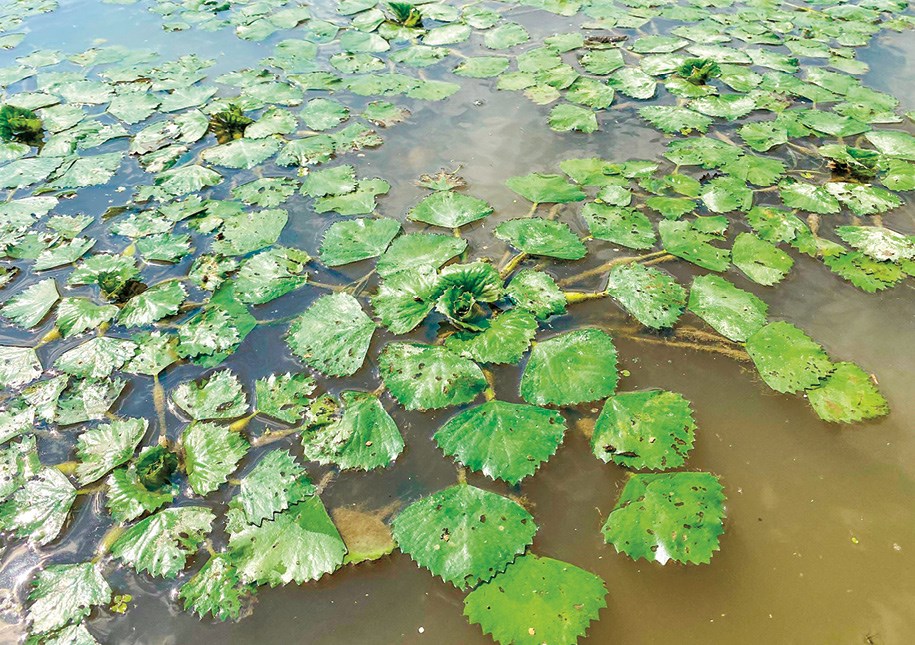NPCA partners with organizations seeking to rescue Niagara waterways from invasive plant species
“Terminate, with extreme prejudice.”
This iconic line from the epic 1979 psychological war film, Apocalypse Now, could well be the marching order of an allied group of environmental organizations, as they gather community support to battle a waterborne menace which is clogging Ontario waterways.
The European Water Chestnut, or EWC (genus name “Trapa natans”) is an invasive aquatic plant that was first detected in the Welland River in 2020. Ontario’s Invasive Species Centre (ISC), located in Sault Ste. Marie, has created a Rapid Response Program to remove EWC from the river, and has joined forces with the Ontario Federation of Anglers and Hunters (OFAH) and the Niagara Peninsula Conservation Authority (NPCA) to control and eradicate the plant.
EWC is a prohibited species in the province under the Ontario Invasive Species Act of 2015. The plant has significant harmful impacts, including reduced biodiversity through the shading out of native aquatic species. Clusters of EWC emerge in late June, and create dense floating mats which impede recreational activities such as swimming, fishing, paddling, and boating. They decompose every year, depleting oxygen levels in waterways, and negatively affecting fish species.
In addition, EWC drop sharp seeds with barbed spines that can accumulate on shore and cause injury when stepped on. Waterfront property values suffer in the presence of the plant.
The goal of the Rapid Response Program is to contain the EWC population within four years, and thereafter implement a monitoring and maintenance program. EWC reproduce from the previous year’s seed, and so removing the plant before it produces seed will lead to its decline. Ducks Unlimited Canada and Ontario Parks have been fighting EWC in Eastern Ontario for several years, and have recorded a 95 percent reduction in the plant through manual removal (hand-pulling) from canoes and small motorboats. The NPCA plans a similar strategy, and will dispose of the EWC biomass on its properties adjacent the Welland River, Chippawa Creek, and the E.C. Brown Conservation Area.
The ISC and NPCA featured a paddling tour at the E.C. Brown Conservation Area on River Road in Fenwick last week, adjacent to the Niagara Central Dorothy Rungeling Airport, in an effort to teach outdoor activists and riverfront landowners how to identify and report EWC infestations on the Welland River. The program will continue throughout the summer and fall.
The ISC’s program coordinator, Karen Alexander, said that the EWC is native to Asia, Europe and Africa, and will continue to grow in abundance until checked.
“The EWC is a real threat to the region’s economy, recreation, and ecology,” she said, “and is now spreading in the Great Lakes. They thrive in full sun, and take root in both shallow and deep water. Biologists detected EWC in the Welland River a few years ago, and we are moving forward with a public education and awareness program to let people, and local municipalities, know that this plant is in the river, and seek their assistance in its removal.”
Alexander recognizes that the Rapid Response Program is a long-term control and monitoring commitment, and that partnerships with stakeholders are critical to its success. She said that an aquatic herbicide has been approved to treat EWCs, but “we're not planning to use herbicide just yet for this population. If we did go down that road, it would be done very carefully with licensed pesticide applicators and permission to do so from the authorities.”
Paddlers and motorboaters should be vigilant when passing through clusters of EMC, said Alexander, since they can loosen up and break free some of the plants, sending them to a new location which will contribute to the spread, exacerbating the problem.
“The speed of the Niagara River would certainly be a deterrent to EMC growth, but there could be some quieter spots along the edges that it settles into,” she said. “The real threat is if it gets into the Niagara River and continues into Lake Ontario, and reaches some of the wetlands in that lake. It could be a really concerning corridor and spread vector.”
Details of the Rapid Response Program are available online at https://www.invasivespeciescentre.ca/take-action/european-water-chestnut-rapid-response-program



